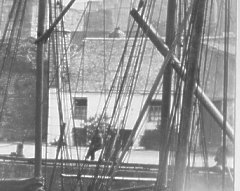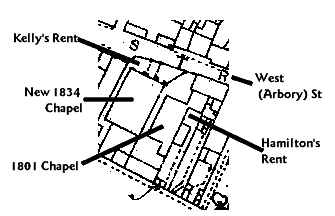
Photo c.1890 - part of larger view of Castle and harbour
According to Mrs E Chapman the Wesleyans first met in a room at back of the Union Hotel. This room I think still exists and is possibly the long building at the rear of the Union hotel which would have faced into the barracks. They then moved to the Lord's stables in Arbory Street. When these burned down, they acquired the site and built a chapel, which became the S/S when the present chapel was built. - This is however obviously wrong in that she has misplaced the Lord's Stables, these were at the north east corner of Market square, approximately behind what is now Manannan house (the old George Hotel, later barracks and later the Commissioners' Offices), the long room at rthe Union may well have been part of the Lord's stables. but would certainly be adjacent to the stables.
In an article in the Methodist Recorder 3 Oct 1889 the author states that he had been unable to determine the date of the first preaching room at Castletown (of which Wesley had said it was too small) but that it stood just at the entrance to the town, and had a flight of stone steps from which Wesley had preached [in1781]. The second chapel was in the upper room of a dwelling place close by the Ordnance Store [presumeably this was the room at the Union]. He goes on to say that tradition has it that more than once the rabble of the town brought out the fire engine to douse the congregation as they entered and left their chapel. This too I think conflates two chapels, the old wash house described below does indeed stand at the entrance to the town and there is a set of steps midway up the street, however the date of acquisition is too late for it to have been used by Wesley. In the diary Wesley mentions preaching houses at Peel and Balleugh (Ballaugh ?) but not Castletown where he preached in the Market place.
Another theory I have been told is that they met in 'the chapel in the Governor's house - again I think this is confused, what is often taken as the Governor's house was the building (later the barracks etc) constructed under Earl James to house the Governor when the Earl wished to occupy Castle Rushen (for which purpose he built Derby House). There was a chapel in the Castle (+ a private chapel for the Lord, now housing the mechanism to drive the 1-fingered clock) and indeed the Lieutenant Governors did occupy that part of the Castle away from the keep when the Derby House became the Rolls Office and Court House. However I seriously doubt if there was ever a chapel in the "Governor's House" on the market square nor if the early Methodists used the one time chapel in the Castle.
A recent discovery of the deed of sale (Malew Deeds 1792 ) dates the first known preaching house to April /May 1792 when James Dinwoody sold for £80, what was the old wash house next to the pigeon house (the Castle redoubt on what is now the later constructed quay). The deed names William Cain, Robert Gell and Robert Kelly of Castletown, William Corrin and Thomas Callister of Rushen, Henry Watterson of Colby, William Fargher and Thomas Quayle of Malew and Thomas Cowley of Santan; witness were William Gell and Ann Corrin (both of whom signed with an X as did Robert Gell and William Corrin). It is possible that William Cain (or Caine) was also a trustee of the first Douglas chapel - the Henry Watterson would fit as the father of the later well known LP Henry Watterson also of Colby (Rosser notes his parents were members for many years), William Fargher was presumeably the leading LP who farmed Cooilcam, Thomas Cowley was another leading LP of that generation. It was described as a 'lately erected house and tenement' whose location is described as adjoining to the pigeon house on one end, to James Dinwoody's rent on the other, to Mr Taubman's rent on the back and to the shore on the front. Dinwoody had purchased it in 1779 (Malew deeds #89 where it is filed as Castletown Preaching house)

Photo c.1890 - part
of larger view of Castle and harbour
Note the unusual corner chimney in the above photo. The Preaching House would appear to have only been in use for 10 years or less,as a rather belated deed of sale states:
Whereas William Caine, Robert Gee, Robert Kelly, William Corrin, Thomas Callister, Henry Watterson, William Fargher & Thomas Quayle the new trustees of Castletown Methodist Society for .. sum of sixty pounds .. paid by Robert Gell junr ... some time in 1802 .. that house and tenement .. one part formerly used and occupied as a preaching house and the other part as a dwelling house which premises were purchased from James Dinwoody ... and whereas the said trustees neglected granting a deed of sale ... to Robert Gell jnr at the time of the said purchase notwithstanding the receipt by them of ... money, ... And whereas Thomas Bell, Thomas Cain, Robert Kelly, William Gick, Robert Gelling, Robert Cannell and John Summers the trustees of the said society for the time being ... do absolutely sell unto ... Robert Gell that dwelling house .. wherein Jno Quirk, Hugh Hudgeon, Mary McGray and Christn Stole at present live
A deed dated 9th February 1801 covers the sale of a parcel of land 43½ ft in length and 25½ ft in breadth 'being near unto the West Street' (now Arbory Street) on which a Methodist Meeting House has lately been erected - it also covered a small yard or passage (4 x 5 yards) leading from the Preaching House and adjoining unto a house called Hamilton's smithy, also included in the sale, described as lately purchased from John Kinvig (of Arbory) which adjoined rent of Robert Kelly on the west and the late John Hamilton on the east.. The sellers were Robert and Elizabeth Kelly, and the trustees named were William Gick, Robert Gell Jnr and Robert Costean of Castletown, Thomas Bell (of Ballanakilley, Malew), John Summers (Rushen) , Robert Cannell and James Kayle (both of Douglas) - the cost was £57.

The trustees also wrote into the deed that they were allowed to have windows high in the side wall and gable adjoining and opposite Robert Kelly's rent and also agreed to erect rain spouts to convery the water away from that rent. As before the deed contained the usual clauses restricting who could preach therein.
This would appear to be the the Arbory street site - Hamilton's smithy was probably along the road (note the description 'near unto') and explains why the old chapel is somewhat set back. The late John Hamilton was rather long deceased - in 1723 John Rothmell, gunner of Castle Rushen transferred his house and brewhouse to his loving nephew John Hamilton, gunsmith, who died 1768.
In 1889 there were only some 90 members of the Wesleyan Chapel out of a town population of some 2,000 - the Castletown circuit comprising in total some 678, so it was the country chapels that were dominant. It would appear that the established church exercised a more dominant position here than elsewhere on the Island.
|
On completion of the new chapel the old one was leased to Mr Whitehead, corn merchant, and it is probable that the pillars were added to strengthen the floor (a hoist was also added). The lease was terminated in 1867 and it became, and still remains, the Sunday School. One immediate observation is the similarity in window design between this and Thomas Brine's St Mary's - is it possible that the frontage is later and dates from the 1820s ?. |
|
|
Grid Reference SC263674 |
|
Opened 6th June 1834 adjacent to the old chapel. The New Wesleyan Methodist Chapel at Castletown. This neat and commodious chapel was opened for divine worship last Friday. The Rev. John Bowers from Stockport conducted the service and preached one of the most luminous sermons ever heard in that town,from I Corinthians v. 23-24. This service was designed chiefly to afford those who attend other places of worship on the Sabbath an opportunity to hear the splendid pulpit talents of Mr. Bowers and of which numbers availed themselves. services were also held in the forenoon, afternoon and evening of Sunday last, when the Rev. John S. Stamp of Liverpool preached in the morning and Rev. Robert Aitken from Crosby preached afternoon and evening. The total sum collected towards defraying the expense of the building (which cost about £900) was £40. The two collections made at the Wesleyan Chapel, Douglas, for the same object amounted to £25 5 shillings. It will be gratifying to friends of Methodism to learn that nearly the whole of the seats are already engaged to hold three times the number of these in the old chapel and it is but justice to add that free sites that will accommodate 150 persons have been reserved for the poor. |
|
|
Grid Reference SC263674 |
Quoting again from the Methodist Recorder [1889]
I looked over the chapel, a quaint, old-fashioned, cramped little place, which an American visitor is reported to have likened to, Noah's Ark, and to have suggested that if it were taken over to his country 'people would come hundreds of miles to look at it as a curiosity.'I am glad to know that it is likely, before long, to be enlarged and modernised. Indeed, plans have been already prepared for the alterations by Messrs. Waddington, of Burnley.
The church was altered in 1890 with the removal of the gallery
round three sides and a single gallery at the Arbory Street or 'west'
end created. The plain 'east' end wall with its pulpit on the left
and choir seats right was replaced by a chancel.
The present organ was installed in 1914 (replacing a smaller,
probably non-pipe organ) and was 'blown' by water.
|
1824,Closed; became Masonic Hall; |
|
|
Grid Reference SC265676 |
|
Closed 1972 when Arbory Street and Malew Street Chapels
merged. Possible architect was Thomas Howdill of Leeds |
|
|
Grid Reference SC264676 |
![]() Castletown
Methodist Church 1834-1984 Anniversity 1984 [MM
E240/30]
Castletown
Methodist Church 1834-1984 Anniversity 1984 [MM
E240/30]
D Corlett Castletown: A descriptive guide[1975]
|
|
||
|
Any comments, errors or omissions
gratefully received The
Editor |
||